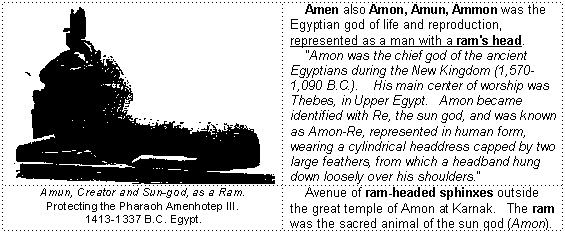
Some of these gods were Osiris and Isis; Ra (Re), a sun-god of the 5th Dynasty; Horus, another sun-god, the son of Osiris and Isis; Set, the rival of Osiris and Horus; Amon-Re, the god of the empire; Ptah, the god of Memphis; Khnum, the god of the Elephantine, an island of southeast Egypt in the Nile River below the First Cataract. In ancient times it was a military post guarding the southern frontier of Egypt. The Elephantine papyruses, dating from the fifth century B.C., were discovered here in 1903.
The Sphinx is an imaginary creature of ancient myths. The Egyptians, Greeks and people of the Near East all had stories about such creatures. According to some stories, the sphinx had a human head, the body of a lion, the tail of a serpent, and the wings of a bird. The great Sphinx at Giza, Egypt has been there at least since 2,515 B.C. and possibly beyond.
Archaeologists have found that in 2,700 B.C., the closing of the Age of Taurus, the Kings of Egypt entered a period of greatness and prosperity.
The priest's headdress was the

Amon (Heb. ‘Amown, aw-mone’, of Egyptian derivation, or ‘amon, i.e. Ammon or Amn, a deity of Egypt used only as an adjunct of Heb. No, thus meaning multitude, populous, it also alludes to one who in the sense of training, skilled, i.e. an architect, one brought up, an expert, cunning workman) but in general is an Egyptian deity that appears in the OT linked with his city, No (Jer. 46:25; Nah. 3:8).
No (Heb. No’, no, of Egyptian origin, also called no’ ‘amon, the city of the god Amon) was a great city and capital of Upper Egypt, south of Cairo and is better known by its Greek name, Thebes. Thebes is now known as the ruins at Karnak and Luxor, which was Egypt’s capital as early as the eleventh century. During the period of the Theban Dynasties (from 1991 B.C.) Amon became the state god of the Egyptian Empire.
Jeremiah 46:25 "The LORD of hosts, the God of Israel, saith: Behold, I will punish the multitude of No (KJV "multitude of No," NIV has "Amon god of Thebes"), and Pharaoh, and Egypt, with their gods, and their kings; even Pharaoh, and all them that trust in him:" The multitude also alludes to the Heb. ‘amown, a variation for Heb. Hamown, haw-mone’, or hamon (Ezek. 5:7), from Heb. hamah, haw-maw, a primary root, thus meaning a noise, tumult, crowd, also disquietude, wealth, thus meaning a throng of people. This punishment refers to the 26th Dynasty as given into the hands of Nebuchadnezzar. Other sources state that No-Ammon, is the same as Thebes or Diospolis in Upper Egypt, where Jupiter Ammon had his famous temples.
Nahum 3:8 "Art thou better than populous No (KJV "No’ ‘amon," NIV "Thebes"), that was situate among the rivers, that had the waters round about it, whose rampart was the sea, and her wall was from the sea?" As in Nahum 3:8 and Ezekiel 30:15 "their gods" makes it translate "Ammon of No," i.e., "No and her idol Ammon," so states the Chaldean version. So-called either from Ham, the son of Noah, or, the nourisher, as the word means. The Ham connection also alludes to the multitude, populous, in the sense of training, skilled, i.e. an architect, one brought up, an expert, cunning workman. Architectural brilliance is a trademark of the Hamitic line from the Table of Nations.

